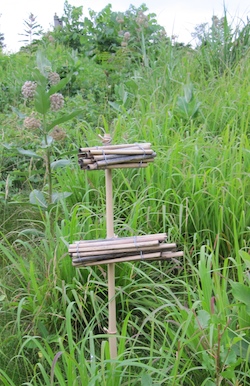Earth Matters focuses on conservation, sustainability, recycling and healthy living. This weekly series is brought to you by Maria Luisa Boutique and Strawtown Studio.
If Earth Matters to you, sign up for our mailing list and get the next installment delivered bright to your inbox.
by Susan Hellauer
As usual, summer’s lease was all too short, and it’s already time to stow the bathing suit and boogie board. The wildlife that shares our neighborhoods, meanwhile, is either getting ready to migrate south or hunker down for winter. Humans have done plenty to interfere with our fellow beings’ world, and a little positive payback is in order. Here are some things you can do to help the most vulnerable creatures prep for migration, or for winter survival right here.
A royal sendoff for migrating monarchs
The monarch butterfly population has been tumbling in recent decades, from habitat loss, pesticide use, our warming planet, and other human-induced causes. Some monarch watchers are reporting greater numbers this year than in the last several years, but others see a still-declining population here in the Northeast.
In its latest Wildlife, Fish & Marine Newsletter, the New York State Department of Environmental Conservation (DEC) shares tips on helping the last wave of monarchs survive their miraculous migratory journey:
Monarch butterflies (Danaus plexippus) begin their annual fall migration in mid to late August. These butterflies are the great-great-grandchildren of the monarchs that migrated south last fall, overwintered in Mexico, and began one leg of the journey north.
You can help monarchs by providing food (nectar) and keeping certain areas protected:
- Turn a portion of your lawn into a wildflower meadow—plant milkweed or other native wildflowers.
- Delay mowing areas with milkweed until later in the fall.
- Avoid using herbicides—they kill all life-stages of monarchs (egg, caterpillar, cocoon, and adult).
- Report sightings of adults online. View a map of the sightings so far this year.
Don’t know when their migration peaks in your area? Check out this chart that breaks it down by latitude.
Stay-at-home birds and bees
Monarch butterflies might be the ultimate pollinator show-stoppers, but their less-flashy colleagues are just as important to the health of our local ecosystem. To find out how to help them winter over, Nyack organic gardener and citizen scientist Laura Pakaln gave us some advice:
If you have a garden, do not deadhead plants like zinnias, coneflowers, sunflowers and other plants producing seeds: Many birds will eat these seeds. In fact, leave these seed bearing plants in your garden all winter to provide a source of food when other sources are not available during winter. You may already have seen this little guy darting in and out of gardens eating seeds.

Male American Goldfinch in spring. Photo: Breck22 [CC BY-SA 3.0]
Think about putting up a bird feeder (seeds and suet) as the weather turns colder and natural sources of food become scarce. Try to put it up in a sheltered area where hawks cannot prey on smaller birds. Here are some tips from the Audubon Society:
- Keep cats indoors so they will not prey on birds and smaller mammals.
- Never feed waterfowl bread! They can develop angel wing syndrome, which can ultimately kill them.
- But consider adding a source of water for birds.
- Keep hummingbird feeders stocked through the early fall to provide helpful energy to migrating birds, but take your feeder down at the first sign of frost or when your feeder freezes for the first time. This will ensure that stray migrants like the rufous hummingbird don’t stay too long and cause concern.
- Provide shelter for bees and other insect pollinators for the winter. Build a pollinator house, or purchase one. They are easy to make and will give pollinators a safe place to winter over in your yard so they will be there in the spring when you need them, and when they are hungry.

Bumble bee habitat in a stand of milkweed and native grasses at Rockland Country Club. Photo: Susan Hellauer
Spring dreams
And when winter’s cold has you musing about your summer garden, consider devoting more space to native plants that bloom in stages from spring through fall. They help support our local pollinators, and a balanced, diverse, and healthy ecosystem.
Learn more:
- “Get Ready for an Exciting Fall Migration” (8/22/19, Journey North)
- “Saving the Mysterious Monarch” (11/4/17, Nyack News and Views)
- “Stop Angel Wing Disease” (11/26/16, Nyack News and Views)
- “Planting Monarch Butterfly Habitats,” by Laura Pakaln (GreenAmerica.org)
- “Get on the Pollinator Pathway, Nyack” (7/10/19, Nyack News and Views)
- “Native Plant Gardening” (6/4/16, Nyack News and Views)
- Sign up for NYS DEC online newsletters
Earth Matters, a weekly feature that focuses on conservation, sustainability, recycling and healthy living, is sponsored by Maria Luisa Boutique, and Strawtown Studio. Read Earth Matters every Wednesday on Nyack News And Views, or sign up for the Earth Matters mailing list.













